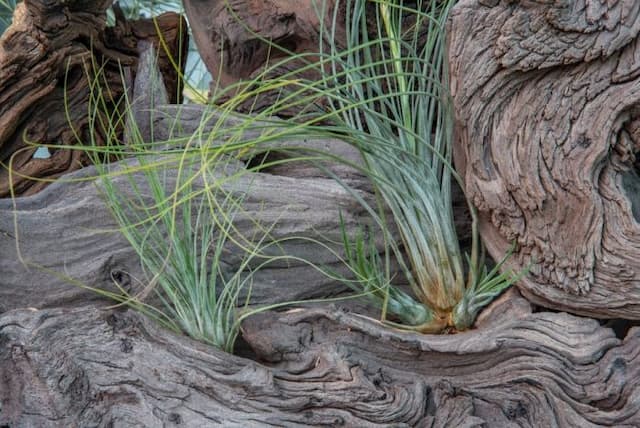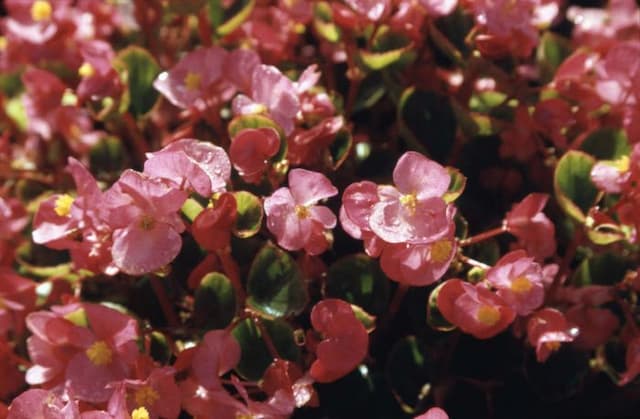Begonia Begonia Memory Series

ABOUT
The Begonia Memory Series features plants that are recognized for their striking foliage and vibrant floral displays. The leaves are typically lush and can come in a variety of shades such as deep green, often with a glossy or waxy appearance. Some varieties within the series might boast leaves with a reddish or maroon reverse, or even possess attractive patterns or markings like spots or borders in contrasting colors. Flowers of the Begonia Memory Series are another highlight, offering a spectacular burst of color. They can range from whites to pinks and reds, with some hybrids showing off bicolored petals. The blossoms are abundant and can come in clusters, blooming profusely under the right conditions. This series of begonias often presents a bushy growth habit, with stems that are succulent and occasionally upright, while in some varieties they might be more trailing. The overall texture of the plant is appealing both visually and to the touch, with fleshy leaves and a robust form that indicates a hearty nature capable of thriving in a variety of environments.
About this plant
 Names
NamesFamily
Begoniaceae
Synonyms
Memory Begonia
Common names
Begonia Memory Series
 Toxicity
ToxicityTo humans
Begonias, including those in the Memory Series, are generally considered not highly toxic to humans. However, they do contain insoluble oxalates which can cause irritation when ingested or if they come in contact with the skin or mucous membranes. If a person ingests part of a begonia, they may experience symptoms such as a burning sensation in the mouth, lips, throat, and tongue, as well as difficulties swallowing, and vomiting. In severe cases, swelling of the oral tissues could potentially lead to difficulty breathing, but such extreme reactions are uncommon. It is always advisable to keep plants out of reach of small children who might ingest them.
To pets
Begonias, including those in the Memory Series, are known to be toxic to pets, especially cats and dogs. The toxic principle in these plants is insoluble oxalates. If a pet ingests part of a begonia, they might experience symptoms such as oral pain, drooling, vomiting, and difficulty swallowing due to irritation and a burning sensation in the mouth, tongue, and lips. In severe cases, ingestion could lead to swelling of the airways, which can cause breathing difficulties. If you suspect your pet has ingested begonia, it is important to contact a veterinarian immediately.
 Characteristics
CharacteristicsLife cycle
Perennials
Foliage type
Deciduous
Color of leaves
Varies
Flower color
Varies
Height
1 feet 6 inches (45.72 cm)
Spread
1 feet 6 inches (45.72 cm)
Plant type
Bulb
Hardiness zones
10
Native area
Tropical South America
Benefits
 General Benefits
General Benefits- Easy to care for: Begonias in the Memory Series are typically low maintenance, making them suitable for beginners or those with busy schedules.
- Long blooming period: These plants often have a long flowering period, providing color and interest for a good portion of the year.
- Shade tolerance: Memory Series Begonias can thrive in shady areas, where other plants might struggle, giving gardeners more options for planting in low-light spaces.
- Variety of colors: Begonias come in a wide range of colors and patterns, which can add vibrancy and aesthetic appeal to gardens and indoor spaces.
- Compact growth: These begonias are known for their compact growth habit, which makes them suitable for containers, hanging baskets, and small garden beds.
- Drought resistance: Once established, Begonias from the Memory Series can tolerate short periods of drought, reducing the need for constant watering.
 Medical Properties
Medical PropertiesThis plant is not used for medical purposes.
 Air-purifying Qualities
Air-purifying QualitiesThis plant is not specifically known for air purifying qualities.
 Other Uses
Other Uses- Begonia Memory Series can be used in crafting as a natural dye, where the blossoms impart color to fabrics or paper.
- They can act as living mulch in gardens, helping to regulate soil temperature and moisture levels.
- With their attractive foliage, Begonias can be part of educational activities for children, teaching them about plant growth and care.
- These plants are sometimes used in photography or art as subjects or inspiration due to their vibrant colors and interesting textures.
- When dried and pressed, Begonia petals can be incorporated into homemade papers or bookmarks for a unique, botanical touch.
- During festive occasions, Begonia flowers can be floated in bowls of water for a decorative centerpiece.
- Petals of the Begonia can be used to create natural confetti for celebrations or weddings, as a biodegradable option.
- Some people use the leaves and flowers of Begonias in compost bins to add nutrients as they break down.
- Begonia plants can serve as a habitat or food source for certain butterfly species, supporting local biodiversity.
- In miniature gardens or fairy gardens, Begonia plants can add a splash of color and create a sense of enchantment.
Interesting Facts
 Feng Shui
Feng ShuiThe Begonia is not used in Feng Shui practice.
 Zodiac Sign Compitability
Zodiac Sign CompitabilityThe Begonia is not used in astrology practice.
 Plant Symbolism
Plant Symbolism- Caution: Begonias are often considered a symbol of caution due to their delicate and sensitive nature, reminding one to be careful in new situations or when dealing with delicate matters.
- Gratitude: Giving begonias as a gift can express gratitude or appreciation, making them a popular choice for thank you bouquets.
- Individuality: With the vast variety of colors and types, begonias can also symbolize individuality and uniqueness, celebrating one's personal traits.
- Harmony: The symmetrical pattern of begonia flowers may represent harmony and balance in relationships or environments.
 Water
WaterFor the Begonia Memory Series, also commonly known as the Wax Begonia, it's important to maintain a consistent watering schedule to keep the soil moist but not waterlogged. Water the plant thoroughly when the top inch of soil feels dry to the touch, which typically means once a week, but this can vary depending on environmental conditions. Use room temperature water, slowly pouring it around the base of the plant, avoiding the leaves to prevent fungal diseases. The amount of water required is usually around 16 ounces for a medium-sized pot, adjusted according to the plant's size and the pot's drainage capacity. Always check the moisture level before watering to avoid overwatering, which can lead to root rot.
 Light
LightWax Begonias thrive best in bright, indirect sunlight. A spot near an east or west-facing window is ideal, where they can receive gentle morning or evening sunlight without the harsh midday rays. Although they can tolerate some amount of shade, insufficient light may lead to leggy growth and fewer flowers, so ensure they receive proper light throughout the day for optimal health.
 Temperature
TemperatureWax Begonias prefer temperatures between 60 and 75 degrees Fahrenheit. They can survive in temperatures as low as 50 degrees Fahrenheit but should be protected from anything colder. Similarly, high temperatures above 86 degrees Fahrenheit can stress the plant, so it's best to maintain a comfortable room temperature environment for ideal growth.
 Pruning
PruningPruning Wax Begonias is beneficial for maintaining their shape and encouraging more robust growth. Pinch back the tips of the stems, especially when the plant becomes leggy or overgrown, to promote bushier growth. The best time to prune is in the spring or early summer, before the plant begins to set buds. Regularly remove any dead or dying leaves and flowers to keep the plant looking its best and to prevent disease.
 Cleaning
CleaningAs needed
 Soil
SoilThe best soil mix for Begonia Memory Series, commonly known as begonias, should be well-draining and fertile with a slightly acidic to neutral pH range of 5.5 to 6.5. A mixture of peat moss, perlite, and pine bark in equal parts can create an ideal environment for these plants, promoting healthy growth.
 Repotting
RepottingBegonias should be repotted every 1-2 years to refresh the soil and accommodate root growth. It's best to repot in the spring, just before the growing season begins.
 Humidity & Misting
Humidity & MistingBegonias thrive at humidity levels of around 50-60%. To provide optimal conditions, a humidifier or pebble tray can be used to maintain humidity around the plant, especially indoors.
 Suitable locations
Suitable locationsIndoor
Provide bright, indirect light and maintain high humidity.
Outdoor
Shelter from direct sun, keep in warm, humid environment.
Hardiness zone
10-11 USDA
 Life cycle
Life cycleThe Begonias, part of the Memory Series, begin their life cycle with seed germination in moist, well-drained soil at warm temperatures, typically in late winter to early spring. Once the seedlings emerge, they enter the vegetative stage, growing leaves and stems, a phase that requires bright, indirect light and protection from extreme weather. As maturity approaches, they start to develop their distinctive flowers, which bloom in a variety of colors, depending on the specific type of Memory Series Begonia, typically in the summer. Following pollination, flowers will produce seeds, completing the reproductive stage of the cycle. After flowering, Begonias often enter a dormant period, especially in cooler climates, where they shed leaves and appear to rest. Following dormancy, they will resume growth from tubers or rhizomes, starting the cycle anew. If the environment is controlled, such as in indoor settings, Begonias might not enter full dormancy but instead slow their growth. Throughout their lives, regular pruning and feeding are essential for maintaining healthy growth and vibrant blooms.
 Propogation
PropogationPropogation time
Spring to Summer
The Begonia Memory Series can be propagated most effectively through leaf cuttings, a method both popular and practical for the intricate foliage of begonias. To do so, a healthy leaf with a bit of stem attached is chosen during the growing season, which typically spans from spring through summer. The leaf is then cut into wedges, each with at least one vein. These cuttings are placed on moistened potting mix or peat moss, ensuring that the vein contacts the soil. The leaf sections are then covered with plastic to maintain humidity. Roots will usually develop within a few weeks, at which point they can be potted separately as new plants. This method allows for the easy production of multiple plants from a single leaf while preserving the unique qualities of the Begonia Memory Series.








![Begonia [Allure]](/_next/image?url=https%3A%2F%2Fplants-admin.emdemapps.com%2Fimages%2Fplants%2F%2Fimages%2F604b5b9006ab9.png&w=640&q=75)
